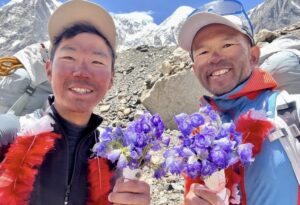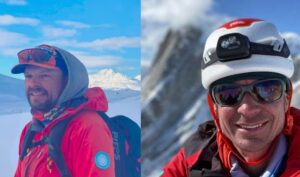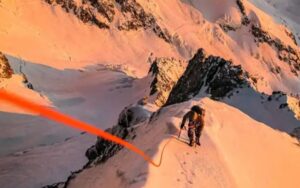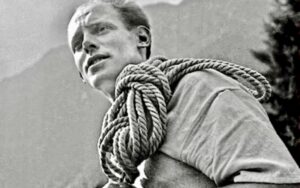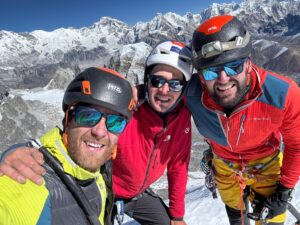Today, ExplorersWeb would like to remember the mountaineers we lost in 2023.
“The deep pain that is felt at the death of every friendly soul arises from the feeling that there is in every individual something inexpressible, peculiar to him alone, and is, therefore, absolutely and irretrievably lost,” wrote philosopher Arthur Schopenhauer.
The full list of climbers and explorers who died this year is much longer than we can include here, but all have our utmost respect.
Zach Milligan

Zach Milligan. Photo: Kristin Anderson
On Feb. 12, Parks Canada found 42-year-old U.S. climber Zach Milligan dead at the bottom of a high ice cliff. The body was near the Polar Circus ice climb in Jasper National Park in the Canadian Rockies. He likely suffered a fatal fall.
Milligan was an experienced free soloist on both rock and ice. He had made hundreds of climbs in North America. In 2021, Milligan and Jason Torlando were the first to ski Yosemite’s Half Dome from the summit to the valley.
The Calgary Herald quoted Milligan’s close friend, climber Chris Van Leuven, who said, “[He was] my favorite dude and I loved his honesty. I loved his personality, his black-and-white way of viewing the world, his dedication to his craft, and his high ethics.”
Ammon McNeely

Ammon McNeely. Photo: Ammon McNeely
Yosemite climber Ammon McNeely always followed his own path. The American climber specialized in big wall and aid climbing. He set several speed records and made the first one-day ascent of many climbing routes on El Capitan.
McNeely had a non-climbing accident on Feb. 18 in Moab, Utah.
“Ammon’s motorcycle was parked. He walked out onto a precipice with his girlfriend and another friend to enjoy the sunset. As Ammon was moving to sit down, he lost the footing under his prosthetic leg and fell backward off the cliff. There’s no need for further speculation,” his sister Amanda Haywood explained.
McNeely survived two serious BASE-jumping accidents around Moab in 2013 and 2017. After the second accident, part of one leg had to be amputated.
McNeely was a much-loved figure within the climbing and BASE jumping community.
“I would rather live 40 years of excitement and fun and exhilaration than 80 years of la-de-da-de-da boring,” he said once.
Noel Hanna

Noel Hanna. Photo: Noel Hanna
Northern Irish mountaineer Noel Hanna lost his life on April 18 at the age of 56. He died after summiting Annapurna I in the Himalaya without supplementary oxygen.
The night before his death, many climbers got stuck in Annapurna’s high camps in very bad weather, eventually running out of food, fuel, and supplementary oxygen (for those using it). Other climbers found Hanna dead in his tent in Camp 4. Acute mountain sickness was the cause of death.
Hanna had climbed Everest 10 times with supplementary oxygen and also attempted Winter K2 during the tragic 2021 season. He loved Nepal, climbing there often. Hanna successfully summited Ama Dablam, Burke Kang, and the foresummit of Manaslu. He also attempted Kangchenjunga. In Nepal alone, he took part in 20 expeditions.
Tom Hornbein

Tom Hornbein. Photo: Jerry Kobalenko
In May, Everest legend Tom Hornbein died at the age of 92. The renowned American mountaineer was fascinated with geology and mountains. An anesthesiologist by profession, he was an early climber in Boulder, Colorado.
In May 1963, together with Willi Unsoeld, he made the first ascent of Everest via the West Ridge. The difficult upper couloir was named after him: the Hornbein Couloir. Their Everest adventure was the subject of the documentary High and Hallowed: Everest 1963.
In 2018, Hornbein was awarded a Lifetime Achievement Award by the Seattle-based Mountaineers Club. Hornbein’s enormous legacy cannot be summed up in a couple of paragraphs, but the mountaineering world has lost a giant.
Line Van Den Berg

Line Van Den Berg. Photo: Line Van Den Berg
Line Van Den Berg, 30, and her two climbing partners, Mats Wentholt and Jeroen van Ommen, were descending from 3,754m Grosshorn in the Bernese Alps when an avalanche swept them away. Emergency services found the bodies two days later.
Van den Berg was an outstanding climber. In January 2022, she ascended the Phantom Direct on the north side of Grandes Jorasses with Fay Manners. In Kyrgyzstan, she summited 5,290m Pik Alexandra and 5,025m Pik Currahee, both via a challenging north face route.
The 2022 documentary My Phantom is an intimate, honest look at Van Den Berg, questioning what it means to be a woman in the climbing community.
“Be honest and real, even, or especially, when that means being vulnerable,” she wrote early this year.
Luis Stitzinger

Luis Stitzinger. Photo: Luis Stitzinger
German mountain guide and skier Luis Stitzinger, 56, summited Kangchenjunga on May 25, but disappeared during the descent. His body was found sometime later.
Stitzinger ascended without supplementary oxygen, topping out quite late, at 5 pm. His initial intention was to ski down but eventually decided against it. At 7 pm, he was still on the mountain’s upper section.
The last contact with Stitzinger was at 9:30 pm when he was still a couple of hours from Camp 4. According to The Himalayan Database, no rescue team arrived that day. On May 27 and 28, helicopter flights were impossible because of the weather. On May 30, a three-sherpa search team found his body at about 8,400m.
Kangchenjunga was Stitzinger’s tenth 8,000m summit. He skied down six of these. Stitzinger did not use supplementary oxygen except on Everest while he was guiding. He ascended six of his ten 8,000’ers with his wife Alix von Melle.
Stitzinger skied several challenging mountains in the Karakoram, including Gasherbrum II, Broad Peak, Nanga Parbat from 7,850m, K2 from 8,050m, Shishapangma, and Gasherbrum I. He also skied the north face of Peak Lenin in the Pamirs.
Szilard Suhajda

Szilard Suhajda. Photo: Szilard Suhajda
On Kangchenjunga this spring, “only” one climber died, Luis Stitzinger. On Everest, it was the most tragic season ever. In total, 18 people lost their lives, among them professional mountaineers, clients, and sherpas. One of them was Hungarian climber Szilard Suhajda, who attempted to climb Everest without bottled oxygen or sherpa support.
Less than 300 vertical meters below the summit, Suhajda disappeared. One of the last images of Suhajda showed him sitting at the Balcony, at 8,450m. He was last seen on May 25, at the bottom of the Hillary Step. Suhajda had previously climbed Lhotse, K2, and Broad Peak.
Dimitry Pavlenko

Dimitry Pavlenko and Svetlana. Photo: Dimitry Pavlenko
Russian alpinist Dimitry Pavlenko, his wife Svetlana, and two clients disappeared on 7,439m Pobeda Peak in the Tien Shan. The team was climbing Pobeda via the Abalakov route on July 19, on a long summit push from 6,100m. They did not summit, turning back at 7,300m.
Their tracker showed that they descended to 7,200m before one of the climbers’ trackers suddenly dropped to 6,580m. An avalanche may have swept the climbers away.
Pavlenko had completed several first ascents on difficult routes in the Tien Shan and he was a member of notable expeditions in the Himalaya, including the West Face of Makalu and the North Face of Jannu by a new route.
Shinji Tamura

Shinji Tamura. Photo: Shinji Tamura
In August, Japanese mountain guide Shinji Tamura died attempting an unnamed 6,800m peak in the Karakoram. He was climbing alpine style with Takayasu Semba in Pakistan’s Kande Valley. On Aug. 11, the climbers suffered an accident. Tamura died and Semba was injured. The search team could not find his body.
Tamura and Semba often targeted alpine-style first ascents. Tamura moved to Zermatt, Switzerland in 1989. Since 2003, he worked as a high-altitude mountain guide.
Tamura was an experienced climber, with expeditions on Everest (which he summited four times), Manaslu (four times), and Cho Oyu (three times). He piled up expeditions elsewhere in the Himalaya and Karakoram too, as well as on Aconcagua, Denali, Mount Logan, and Vinson in Antarctica.
Ermanno Salvaterra

Ermanno Salvaterra. Photo: Jacob Balzani
On Aug. 18, Italian mountain guide Ermanno Salvaterra, 68, died on Campanile Alto’s west ridge in the Brenta Dolomites. Salvaterra fell on the last section of the Hartman-Krauss route while leading a pitch. He fell around 20m from 2,750m.
Salvaterra established several routes in the Dolomites over 50 years. He spent time climbing the huge towers of Patagonia, his second home. In particular, Salvaterra mastered Cerro Torre, where he opened five new routes. In 1985, he was part of the team that made the first winter ascent of Cerro Torre.
Dmitry Golovchenko

Dmitry Golovchenko. Photo: Mountain.ru
One of the best contemporary climbers, Russian Dmitry Golovchenko died on Aug. 31 while attempting 7,925m Gasherbrum IV with his friend Sergey Nilov. The pair were climbing a new route, via the unexplored southeast ridge.
The climbing community was following their expedition when, at the end of August, contact from the climbers suddenly stopped. There was no further public information on them for five days.
After weeks of slow progress and bad weather, the two climbers reached 7,684m on Aug. 31. A mere 250 vertical meters below the summit, the accident happened. Golovchenko slipped and fell, carrying their tent into the void. Nilov was outside the tent at the time, trying to secure it.
Nilov had to descend the dangerous route alone, rappeling 15 difficult pitches to where Golovchenko had fallen. Sadly, Golovchenko was dead.
Forty-year-old Golovchenko had completed several world-class climbs. He was awarded the Piolet d’Or twice, for Thalay Sagar and Muztagh Tower.
Juan Senoret and Christophe Henry

Christophe Henry (left) and Juan Senoret. Photo: Daniel Ronnback/Juan Senoret
Two extreme skiers, Chilean Juan Senoret and Christophe Henry of Chamonix died on the upper slopes of 2,493m Volcano Puntiagudo in Chile. They fell to their deaths while skiing down.
Henry was known for his super-fast descents of Chamonix’s classic lines. The Piolet d’Or committee listed Senoret’s first ascent of the north face of 2,168m Cerro Catedral in Torres del Paine with his brother Cristobal Senoret as one of the most significant climbs of 2022.
Nadya Oleneva

Nadya Oleneva. Photo: Masha Gordon
In October, Russian climber Nadya Oleneva lost her life on 8,167m Dhaulagiri in Nepal. Oleneva, Roman Abildaev, and Rasim Kashapov were climbing without supplementary oxygen or sherpa support.
Oleneva fell from about 6,600m, shortly before reaching Camp 2. The 38-year-old was a mountaineering instructor and a highly experienced alpinist.
Tenjen Lama Sherpa

Tenjen Lama Sherpa. Photo:Tenjen Lama Sherpa
Tenjen Lama Sherpa died on Shishapangma while accompanying client Gina Marie Rzucidlo in October. The avalanches cost the lives of four people (two clients and two Nepalese sherpas), in one of the worst accidents in the Himalaya this year.
Tenjen Lama was with Alex Txikon on winter Manaslu and led Kristin Harila on every stage of her 14X8,000’er speed record, sharing the achievement.

